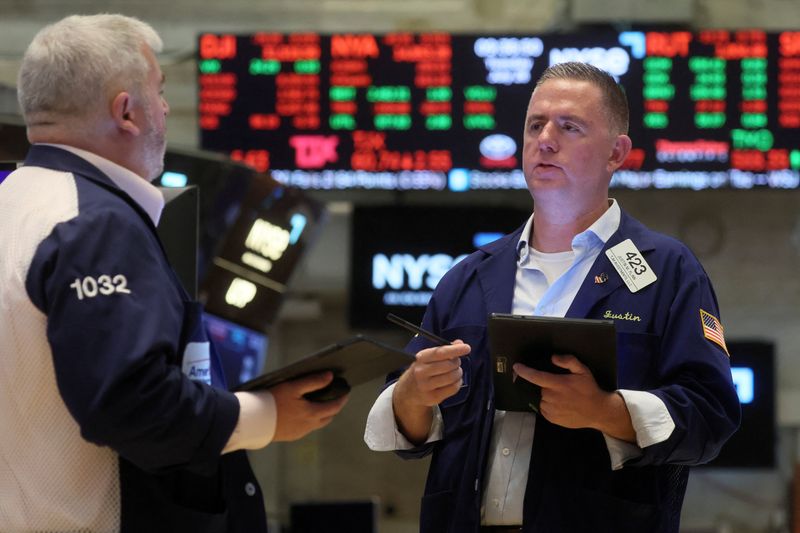Wall Street ends sharply lower as jobs report cements rate hike regime
2022.10.07 16:47
[ad_1]

© Reuters. Traders work on the floor of the New York Stock Exchange (NYSE) in New York City, U.S., July 26, 2022. REUTERS/Brendan McDermid
By Herbert Lash, Shreyashi Sanyal and Ankika Biswas
(Reuters) – Wall Street fell sharply on Friday following a solid jobs report for September that increased the likelihood the Federal Reserve will barrel ahead with an interest rate hiking campaign many investors fear will push the U.S. economy into a recession.
The Labor Department reported the unemployment rate fell to 3.5%, lower than expectations of 3.7%, in an economy that continues to show resilience despite the Fed’s efforts to bring down high inflation by weakening growth.
Nonfarm payrolls rose by 263,000 jobs, more than the 250,000 figure economists polled by Reuters had forecast. Money markets raised to 92% the probability of a fourth straight 75 basis-point rate hike when Fed policymakers meet on Nov. 1-2, up from 83.4% before the data.
The job gains, lower unemployment rate and continued healthy wage growth point to a labor market Fed officials will likely still see as keeping inflation too high.
In the latest of a steady stream of hawkish messages by policymakers, New York Fed President John Williams said more rate hikes were needed to tackle inflation in a process that will likely increase the number of people without jobs.
The data cemented another jumbo-sized, 75 basis-point rate hike in November as “the labor market is still way too hot for the Fed’s comfort zone,” said Bill Sterling, global strategist at GW&K Investment Management.
“This was a classic case of good news is bad news,” he said. “The market took the good news of the robust labor market report and turned it into an ever-more vigilant Fed and therefore potentially higher risks of a recession next year.”
One economist said the Fed should not be reassured by the tight labor market because when the unemployment rate begins to rise, it does so quickly and is a leading indicator of a recession.
“We haven’t felt the full effects of the tightening,” said Joseph LaVorgna, chief U.S. economist at SMBC Nikko Securities. “They’re going to keep going until eventually this thing turns over, and when it turns over you won’t be able to slow the momentum.”
Next week’s consumer price index will provide a key snapshot of where inflation stands.
Despite a hefty two-day rally earlier in the week, Friday’s nosedive pushed the to fall for a fourth straight week, while the Dow and the Nasdaq posted their seventh consecutive weekly declines.
According to preliminary data, the S&P 500 lost 103.90 points, or 2.77%, to end at 3,640.62 points, while the Nasdaq Composite lost 418.49 points, or 3.78%, to 10,654.83. The Dow Jones Industrial Average fell 620.95 points, or 2.07%, to 29,305.99.
All 11 major S&P 500 sectors declined, with technology falling the most.
The fell after a revenue warning from Advanced Micro Devices (NASDAQ:) signaled a chip slump could be worse than expected. The index was poised for its biggest single-day percentage decline in nearly a month.
AMD was among the largest decliners on the , as its third-quarter revenue estimates were about $1 billion lower than previously forecast.
GRAPHIC: Chips underperform on Wall Street –
FedEx Corp (NYSE:) slid after an internal memo seen by Reuters showed the division that handles most e-commerce deliveries expects to lower volume forecasts as its customers plan to ship fewer holiday packages.
[ad_2]
Source link








